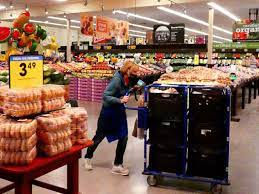US Sees Major Progress on Fighting Inflation
- Better Neighbors Network

- Jun 29, 2023
- 3 min read

Photo by Wall Street Journal
According to the Bureau of Labor Statistics' report on Tuesday, consumer price growth in May slowed down, reaching its lowest level since March 2021. On an annual basis, price growth dropped to 4%, while month-over-month growth increased by only 0.1%. These figures were slightly better than economists' forecast of 4.1% and were significantly lower than the 4.9% rate observed in April. This data indicates that inflation and the accompanying high prices are finally starting to decrease noticeably.
Notably, there was a decrease in the growth of service prices, such as medical services and air travel, which is an important category closely monitored by the Federal Reserve due to its slow decline. In May, the "core" services category, excluding housing costs, decreased from 5.1% to 4.6% compared to the previous year.
While declines in prices were observed across various sectors, food prices continued to rise at a faster pace than other categories, with an overall year-on-year increase of 6.7%. Prices for food at home increased by 5.8%, while prices for food away from home climbed by 8.3%.
After reaching a 40-year high of over 9% about a year ago, analysts are now debating the speed at which inflation will continue to decrease.
However, certain factors have not experienced such dramatic declines. Citibank economists noted in a client note on Monday that workers' pay increases have remained substantial, averaging around 6% since March 2022. They believe this pace indicates underlying price inflation will stabilize at around 4.5% to 5%.
Grocery prices, particularly those for food ordered online, have also continued to rise rapidly. Data from the Adobe Digital Price Index in May showed an 8.2% increase in prices for online groceries over the past 12 months. Although this metric is down from its peak of 14.3% in September, consumers are increasingly purchasing more groceries online, causing the category to align closely with the official Consumer Price Index.
Food prices, like other sectors, are influenced by factors such as higher wages. Jayson Lusk, a professor and head of the Department of Agricultural Economics at Purdue University, pointed out that wages in the food service industry have risen over 20% compared to pre-pandemic levels. Lusk attributed the causes of food price increases to factors like labor, transportation, and real estate costs.
As the Federal Reserve aims to bring the overall inflation rate down to 2%, it is expected to maintain the key federal funds rate at approximately 5% during its upcoming interest rate policy announcement. By increasing the cost of borrowing and investing, the Fed hopes to reduce demand for goods and services in the economy.
The focus has also now shifted to price increases in services, particularly travel-related expenses such as airfare and hotel costs, which continue to rise rapidly and may keep inflation elevated. Joe Davis, chief global economist at Vanguard, and Andrew Patterson, a senior international economist at Vanguard, noted that “the magnitude of price increases in services has not slowed down enough to ensure inflation is on a path towards 2%”. They attributed this persistence to ongoing wage increases and suggested that a reduction in labor market pressures would be crucial in lowering this component of inflation. Patterson added that employment in the leisure and hospitality sector has not fully recovered to pre-pandemic levels, leading to higher wages in lower-wage industries. As long as workers in these sectors continue to face higher household inflation, they are more likely to demand increased wages, and it will take time for this dynamic to change.

